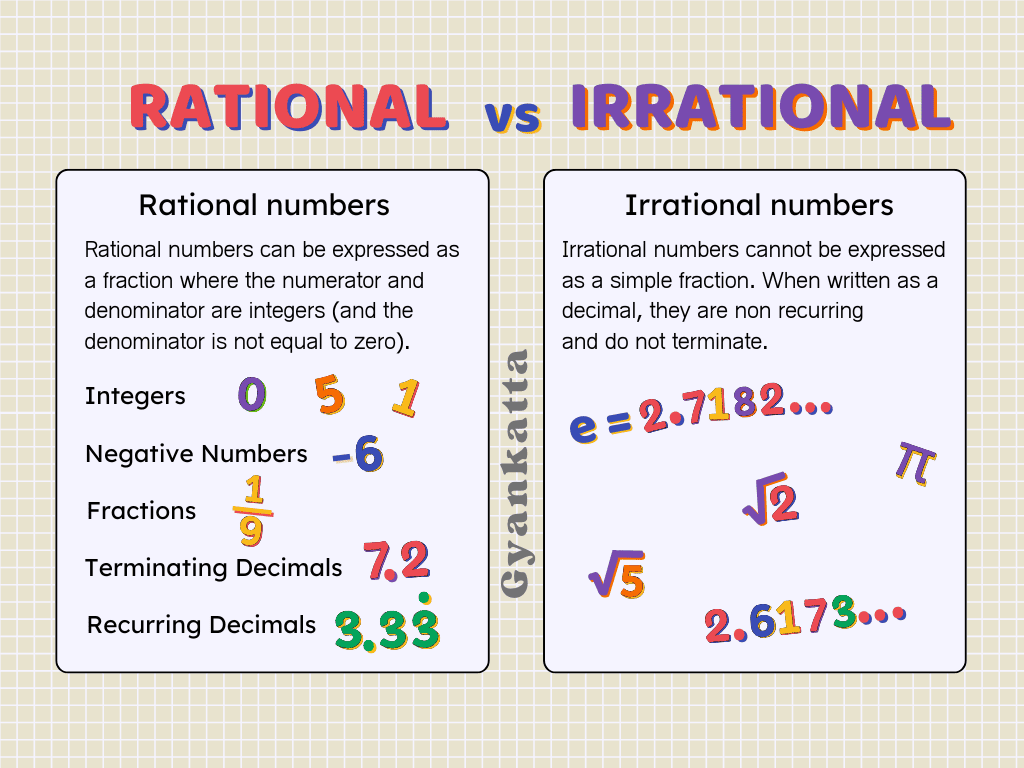Class 8 Math Rational Numbers Notes
Rational Numbers – Class 8
Hi kids! This chapter is all about numbers called Rational Numbers. Don’t worry, they’re not as scary as they sound!

What are Rational Numbers?
A rational number is any number that can be written as a fraction, where both the top (numerator) and bottom (denominator) are whole numbers, and the bottom number is not zero.
Examples: 1/2, 3/4, -2/5, 7, 0, -10/3
Non-Examples: √2 (square root of 2), π (pi)
Think of it like sharing a pizza! If you cut a pizza into 8 slices, and you take 3, you have 3/8 of the pizza. That’s a rational number!
Properties of Rational Numbers
1. Closure Property:
When you add, subtract, multiply, or divide (except by zero) two rational numbers, the answer is always another rational number.
2. Commutative Property:
You can add or multiply rational numbers in any order. The result stays the same.
Example: 1/2 + 2/3 = 2/3 + 1/2
Example: 1/2 * 2/3 = 2/3 * 1/2
3. Associative Property:
When adding or multiplying three or more rational numbers, you can group them in any way you like. The result stays the same.
Example: (1/2 + 1/3) + 1/4 = 1/2 + (1/3 + 1/4)
Example: (1/2 * 1/3) * 1/4 = 1/2 * (1/3 * 1/4)
4. Distributive Property:
Multiplication distributes over addition. This means a(b + c) = ab + ac
Example: 1/2 * (1/3 + 1/4) = (1/2 * 1/3) + (1/2 * 1/4)
5. Identity Property:
Adding 0 to any rational number doesn’t change it. Multiplying any rational number by 1 doesn’t change it.
Example: 5 + 0 = 5
Example: 5 * 1 = 5
6. Inverse Property:
Every rational number has an additive inverse (opposite) and a multiplicative inverse (reciprocal).
Additive inverse of 3 is -3. 3 + (-3) = 0
Multiplicative inverse of 2/3 is 3/2. (2/3) * (3/2) = 1
Operations on Rational Numbers
1. Addition:
To add fractions with the same denominator, add the numerators. If they have different denominators, find a common denominator first.
2. Subtraction:
Similar to addition, but subtract the numerators.
3. Multiplication:
Multiply the numerators and multiply the denominators.
4. Division:
To divide by a fraction, multiply by its reciprocal.
Keep practicing, and you’ll become a rational number whiz!
Rational Numbers Questions
1. Which of the following is a rational number?
a) √3 b) 0 c) π d) √5
2. What is the additive inverse of -4/7?
3. What is the multiplicative inverse (reciprocal) of 5/2?
4. Simplify: 2/3 + 1/4
5. Simplify: 3/5 – 1/2
6. Simplify: (2/3) * (3/4)
7. Simplify: (4/5) ÷ (2/3)
8. Which property is illustrated by: 2/5 + 3/5 = 3/5 + 2/5?
9. Which property is illustrated by: (1/2) * (2/3 + 1/4) = (1/2 * 2/3) + (1/2 * 1/4)?
10. Is -7/8 greater than -5/6?


